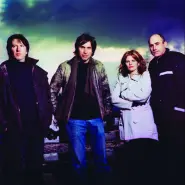4 Meanings
Add Yours
Follow
Share
Q&A
Just want to see Lyrics
I don't want to be no patch on no quilt
(I just want to see...)
Tear-stained stitching linking memories to guilt
(I just want to see...)
I don't want to be no hair on no wall
(I just want to see...)
Blood-stained note saying fuck you all
(I just want to see what kills me)
Tommy, are you ready we better head to town
J.D.'s box is waiting to be lowered down
and you know how he hates to be kept waiting 'round
I don't want to be no chalk line drawing
(I just want to see...)
Toe-tagged question mark, until identifying
(I just want to see...)
I don't want to fuse with no economy seat
(I just want to see...)
fuel some fireball at 30,000 feet
(I just want to see what kills me)
Tommy, did you catch his face
before they closed the lid?
I swear I saw him wink once and flash me that old grin
Oh, you know, that would be just like him
I don't want to face no hollow-eyed ending
(I just want to see...)
Loved ones buried, empty days of waiting
(I just want to see what kills me)
Tommy, darling, come to bed
we'll try and sleep away this sadness
These memories, too, are bound to die
so our dreams will have to serve us
Tomorrow may be the day that our love betrays us
(I just want to see...)
Tear-stained stitching linking memories to guilt
(I just want to see...)
I don't want to be no hair on no wall
(I just want to see...)
Blood-stained note saying fuck you all
(I just want to see what kills me)
J.D.'s box is waiting to be lowered down
and you know how he hates to be kept waiting 'round
(I just want to see...)
Toe-tagged question mark, until identifying
(I just want to see...)
I don't want to fuse with no economy seat
(I just want to see...)
fuel some fireball at 30,000 feet
(I just want to see what kills me)
before they closed the lid?
I swear I saw him wink once and flash me that old grin
Oh, you know, that would be just like him
(I just want to see...)
Loved ones buried, empty days of waiting
(I just want to see what kills me)
we'll try and sleep away this sadness
These memories, too, are bound to die
so our dreams will have to serve us
Tomorrow may be the day that our love betrays us



Add your song meanings, interpretations, facts, memories & more to the community.
An excellent song.
A song about (I think) living life knowing that you're gonna die eventually and how she just wants to go to sleep and not think about it and enjoy her dreams instead.
Wow, that was worded badly. Oh well. This song needed some comments.
If you aren't paying close attention you might miss little details of very intentional and specific death scene quotes.
If you aren't paying close attention you might miss little details of very intentional and specific death scene quotes.
These deaths all say "I don't want to be...(quotation) because it will be seen as ...etc.
These deaths all say "I don't want to be...(quotation) because it will be seen as ...etc.
"Chalk outline" = dead for hours, all alone, until police found my body "no hair on no wall" = mistaken for a criminal because I took a gunshot would to the head. "a patch" on a memorial quilt = PITIED by everyone who used to treat me as an equal-- because I have aids or breast cancer. "blood-stained note saying fuck you all" = AN ANGRY...
>
The blood-stained note was what started me off--of course this was a suicide. "J.D." was the victim. The narrator (let's call her Margo) knew J.D. (she's going to his funeral) and she doesn't want to be part of the reason he killed himself (patch in a quilt.) If she is, she'll link the "memories [that she had with him] to guilt." She goes to town with Tommy, her lover. (They live together, and the last line says they love each other.) Tommy also knew J.D. ("you know that would be just like him") and I sense a positive relationship. "Tomorrow may be the day that our love betrays us" makes me think that perhaps J.D.'s love betrayed him. I think that love was Margo, and she's now dating who was determined to be his friend, Tommy. Margo's probably saying that we love each other now, but tomorrow someone may come between us and we'll be ruined. She just wants to see how she dies, becuase she wants to see if it's the same way. Will Tommy's love betray her?
(golf clap...)Nice hypothesis ZellaL! Your narrative is logical and well supported. But it is also a bit oversimplified and literal. What I mean is this: if my analysis doesn't explain why the song makes my eyes get wet, or why I have to listen to it at least 4 times in a row, then it's not good enough...I haven't really grasped the song's meaning at all.
When we interpret poetry and fiction (or really good lyrics!) "figuring it out" is more than creating logical hypotheses and missing facts to fill in the narrative gaps. You do yourself a disservice by treating the song as a puzzle or game of '20 questions.'
You also must figure out what's ambiguous in the poem, and what's irrefutable? Where is the tension? What does she (narrator) reveal in her word choice, imagery, repeated words/phrases, ideas, mood, pace, etc.
For example:
Question 1 What is the problem/crisis she's having? It's obviously death, because JD just died, right? A: WRONG! This song is not about death; it is about SEEING ourselves and others clearly--in life and in their deaths.
After JD died, she noticed how her perception of him didn't alter with his dying. This got her thinking about how others might see her, and wondering how it may change after her death (or because of her death).
She wishes, perhaps, she could peek into the future and see what the value of her life was (to her friends, family, colleagues, children) so maybe then she could stop fearing the unknown. And stop being tempted to kill herself when her feelings of self-doubt is too heavy to bear.
Question 2 Q:What is the narrator's mood? weary? passionate? joyful? desperate? A: it changes with each stanza, and adds a new mood in the last stanza: Mood 1/ Mood 2/ Mood 1/Mood 2/ Mood 1/ Mood 3. Mood 1 is weary and worried, but also reflective and inquisitive. Mood 2 is cheerful and comforting, (to distract herself and Tommy from their grief by remembering how kind JD was). Mood 3 is the big surprise. Death is no tragedy if others have SEEN you in a positive light--if you have helped others and improved humanity in some small way. Loneliness and isolation are the more soul-threatening problems (e.g., if you've lost your family, friends, community and have no relationships left.)
Question 3: Mood in Stanza 6 Q: What is implied (in last stanza) when "memories...die" and dreams replace them? A: She is sad and melancholy, of course, but she has this moment of clarity in which she sees how our lives mean very little. In our brief time on earth we should focus on the people we love: loving, caring for, challenging, and helping each other. We can't fight what time and grief do to us (we are too tired to fight this sadness, Tommy, so let's rest) and minds (memories are lost). Even young people lose or alter memories without being aware of it.
Sorry--I meant to add this:
Sorry--I meant to add this:
"We can't fight what time and grief turn us into. We are too tired to fight this sadness, Tommy, so let's rest our bodies and minds (our memories are fading anyway, just let go...).
"We can't fight what time and grief turn us into. We are too tired to fight this sadness, Tommy, so let's rest our bodies and minds (our memories are fading anyway, just let go...).
Even young people lose or alter memories without being aware of it. Since memories are so fragile--we can't count on anything being "the truth." Therefore, the sad truth is that perception IS reality.
Even young people lose or alter memories without being aware of it. Since memories are so fragile--we can't count on anything being "the truth." Therefore, the sad truth is that perception IS reality.
I just wish I could see what that perception is? It kills me to not know!"
I just wish I could see what that perception is? It kills me to not know!"
the patch in a quilt refers to an AIDs quilt from the 90's where they sewed AIDS victims names into the quilt